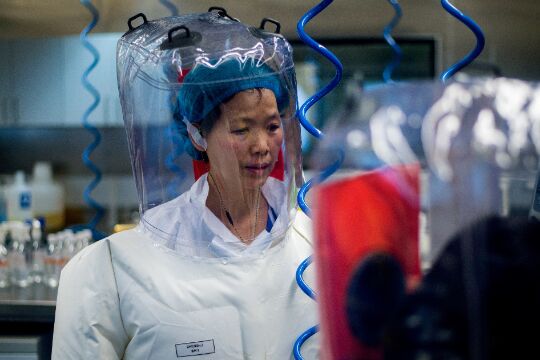Tracing the virus
While the Chinese cooperation with global efforts of finding Coronavirus’ origin remains uncertain, India can elicit significant clues through investigation in Nagaland

The recently concluded G7 Summit demanded fresh investigations into the origin of COVID-19. It has been nearly 18 months since the Coronavirus brought the world on its knees — affecting around 177 million people and causing over 3.8 million deaths. India is among the worst affected countries with overall 29.5 million cases and 374,000 deaths. The deadly second wave is still far from over, and the third wave may be around the corner. No one can tell when this nightmare will end, but it is necessary to conduct an honest inquiry into its beginning and China's role.
The Prime Minister, while addressing the first outreach session of G7, emphasised sending out a message of "One Earth One Health" to the whole world. He said in a veiled attack on China that it was the responsibility of democratic and transparent societies to prevent future pandemics!
Speaking at the same session, the World Health Organisation (WHO) Director-General, Tedros Ghebreyesus, urged China to cooperate with the ongoing investigation into the COVID-19 origin. Earlier, on May 28, the External Affairs Ministry had also called for wider cooperation with the WHO, without particularly naming China.
A recent joint statement by Joe Biden and Boris Johnson read: "We will also support a timely, transparent and evidence-based independent process for the next phase of the WHO-convened COVID-19 origins study."
Biden has additionally ordered a US intelligence inquiry into the origins of COVID-19, following the renewed concerns over the possibility that the outbreak might have occurred due to a laboratory leak in China. Further, scientists also emphasised the need for a fresh probe into the matter.
One such study by British professor Angus Dalgleish and Norwegian scientist Birger Sorensen has found that the SARS-CoV-2 virus has no "credible natural ancestor" and was created by Chinese scientists who were working on a 'Gain of Function' project at the Wuhan Institute of Virology. 'Gain of Function' research is an attempt to make viruses/pathogens more pathogenic so that they could be transmitted easily.
At the centre of this controversy is Shi Zhengli, an expert on SARS-like coronaviruses of bat origin. Known as China's 'bat woman' for her research expertise in the bat-virus connection, Shi is also the Director of Centre for Emerging Infectious Diseases at the Wuhan Institute of Virology. Her research, based on samples from a bat cave in 2012, has assumed significance in the probe to determine the origins of the SARS-CoV-2 — the virus behind the COVID outbreak.
After the outbreak of the pandemic, Shi has become a controversial figure under attack by conspiracy theorists who allege a connection between the origin of the virus and WIV. Despite the WIV presenting itself as a civilian institution, the US State Department has asserted that the WIV has collaborated on publications and secret projects with Chinese military, and also engaged in classified research including laboratory animal experiments since at least 2017.
In 2012, six miners had fallen sick while working in a bat cave in the Mojiang province of China — out of which three had died. They showed symptoms of COVID-19, including cough, pneumonia and blood clotting. This incident led to Zhengli's research that concluded with the identification of RaTG13 which, according to experts, is the closest known relative of SARS-CoV-2. The allegation is that Shi Zhengli used the virus from the bats to create the more pathogenic and dangerous coronavirus.
Monali Rahalkar, an Indian scientist, has said: "If Zhengli brings some viruses from the caves and develops it in such a way to make them bind easily to the human cells, then it will become more infectious."
The Indian media has reported that in 2017, Shi Zhengli and Xinglou Yang (another Chinese scientist from the Wuhan Institute of Virology) visited Nagaland and collected blood samples of Nagas of the Bomrr tribe that has been harvesting bats for at least seven generations as a source of food and traditional medicine. The two virologists were part of a team that also included Indian and US scientists. The project was funded by the US Department of Defense, the Defense Threat Reduction Agency (DTRA), the Biological Defense Research Directorate of the Naval Medical Research Centre and from an award granted by the Department of Atomic Energy, Government of India.
Every year, the Bomrr tribe members smoke out a cave full of bats, hunting and killing these mammals as they exit through the mouth. In the process, they're exposed to the bats' blood, saliva and faeces. During the 2017 bat harvest, the above-mentioned team of scientists drew blood from 85 willing donors. They also collected blood, kidney, lung and spleen samples from the bats.
The project on 'bat harvesting' was presented to the San Francisco-based Public Library of Science (PLOS) — a reputed non-profit open-access science, technology and medicine publisher of academic journals. It published the study 'Filovirus reactive antibodies in humans and bats in Northeast India imply Zoonotic spillover' on October 31, 2019. The term zoonotic spillover means the transmission of a pathogen from a vertebrate animal to a human. There is a disclaimer though: "funders had no role in the study, design, data collection and analysis, decision to publish, or preparation of the manuscript."
The Indian Council of Medical Research reportedly did an inquiry into the matter which was submitted to the Government. The Government should get to the bottom of this matter. It is also necessary that stricter norms for such research studies by foreigners be laid out.
It remains to be seen whether or not China will permit an in-depth inquiry into the origins of coronavirus. But the Indian Government must conduct a thorough inquiry into the 2017 visit of the Chinese virologists in order to ascertain whether it had any connection with the ensuing pandemic.
Views expressed are personal



